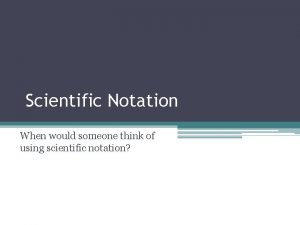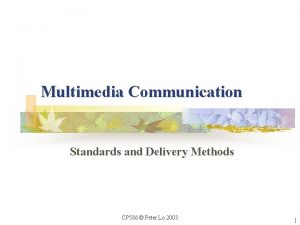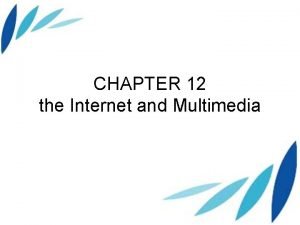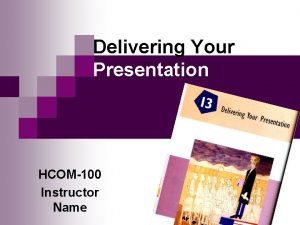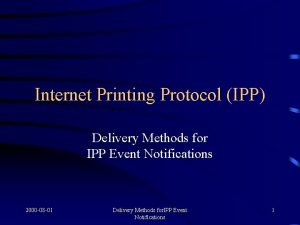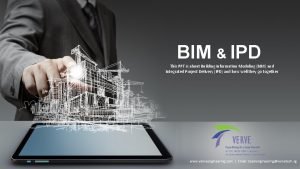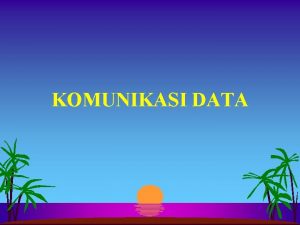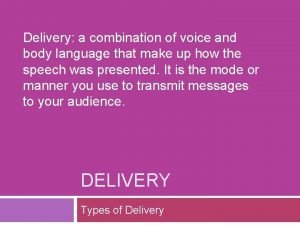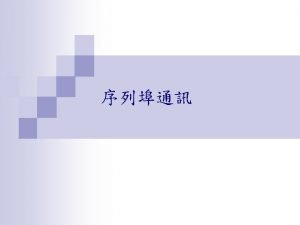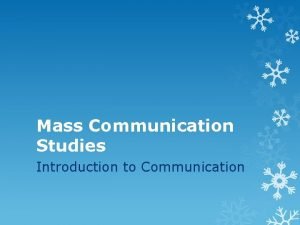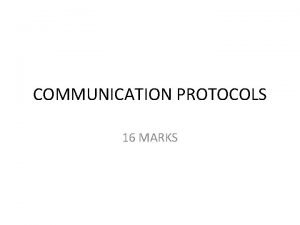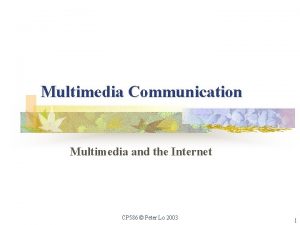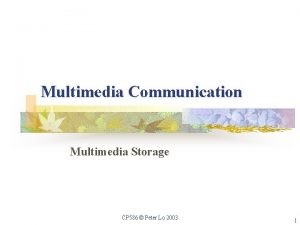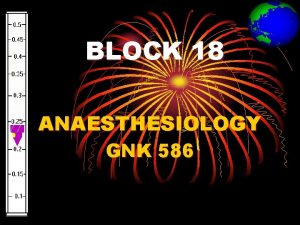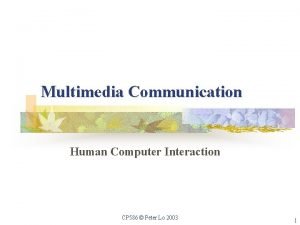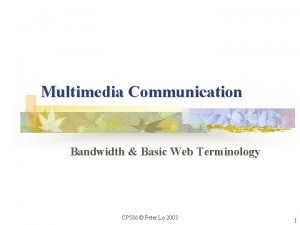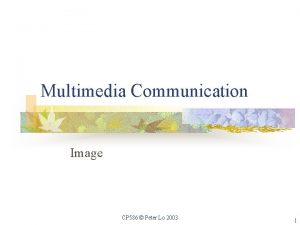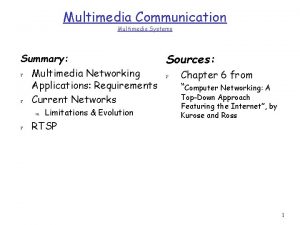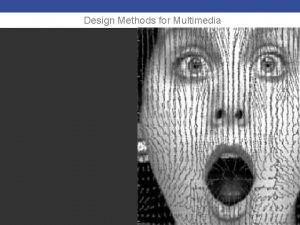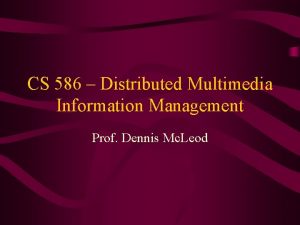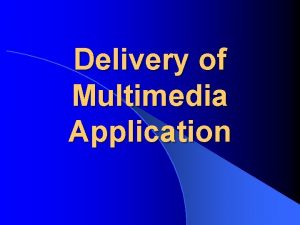Multimedia Communication Standards and Delivery Methods CP 586






















- Slides: 22

Multimedia Communication Standards and Delivery Methods CP 586 © Peter Lo 2003 1

Definition of Multimedia n The interactive use of audio, still image, graphics, animation, text and motion video. CP 586 © Peter Lo 2003 2

Industry Standards n n n The multimedia industry is extremely competitive and develops a variety of new hardware and software on a regular basis. It is not uncommon for developers to create different solutions to the one problem. Standards offer the advantage of making products readily interchangeable, increasing competition, consistent file formats and reduced training. CP 586 © Peter Lo 2003 3

What are Standards? n n A definition or format that has been approved by a recognised standards organisation or is accepted as a de facto standard by the industry. That which is established by authority as a rule for the design and measure of quantity, extent, value, or quality. CP 586 © Peter Lo 2003 4

Why use standards? n n n Multimedia applications depend on the operating system and hardware far more than other types of software. Without standards it would be impossible to develop multimedia applications. The primary benefit of standards is to make hardware and applications that run on any platform and operating system that is designed to recognise that standard. CP 586 © Peter Lo 2003 5

Standard Organisations n n ANSI: American National Standards Institute. IEEE: Institute of Electrical and Electronic Engineers. ISO: International Standards Organisation. VESA: Video Electronics Standards Association. CP 586 © Peter Lo 2003 6

Computer Architecture n n n Processor: Intel Pentium, AMD and IBM. Memory: RAM, ROM and HDD. Input: Keyboard, mouse and microphone. Output: Projection device, high resolution monitor, speakers, amplifier and printer. Control: Operating system, BIOS (Basic Input Output System) and software to control the program. CP 586 © Peter Lo 2003 7

Architecture Standards n n Standards help determine what is compatible to a particular platform. Standards are usually driven by market leaders and technological pioneers. Unfortunately, this does not mean that software or hardware is optimal in terms of speed or efficiency. However competition keeps prices down. CP 586 © Peter Lo 2003 8

Operation Systems (OS) n A Operating System is a software program that helps the user interact with a computer. It controls the input, output and processing activities for a computer. n n n Boot the machine (Load the OS into PC’s memory) Controls the resources of the computer included computer memory, file storage space and the computer processor (CPU). Provides an interface between the hardware and the user. Allows the computer to perform primitive operations on computer hardware and provide an abstract representation of these actions to the user. Helps all the hardware components communicate with each others. There are utility programs contained within OS that help you do things like copy file. CP 586 © Peter Lo 2003 9

Functions of an Operating System q start up the computer q monitor performance q manage memory and provide housekeeping q administer security q manage programs services q control a network qschedule jobs and configure q provide user interface q access the Web devices CP 586 © Peter Lo 2003 10

Where is the Operating System located? operating system resides on hard disk in most operating system cases resides on ROM in handhelds CP 586 © Peter Lo 2003 11

OS Interface n Command Line Interfaces n n You must type in what you want the computer to do, and you must type it correctly. Graphic User Interface (GUI) n A GUI let you click with the mouse to start a program or do other computer task. CP 586 © Peter Lo 2003 12

Booting n Booting is a process of starting or restarting a computer Cold Boot: Process of turning on a computer after it has been powered off completely cold boot n Warm boot: Process of restarting a computer that is Process of turning on on a warm boot already powered n computer after it has been powered off completely Process of restarting a computer that is already powered on CP 586 © Peter Lo 2003 13

What messages display on the screen when you boot up? BIOS version and copyright notice total amount of memory devices detected and tested Windows message sound card and CD -ROM drivers loaded CP 586 © Peter Lo 2003 14

Multimedia Standards n n n JPEG : The Joint Photographic Experts Group. MPEG : Moving Pictures Experts Group. Quick. Time : Macintosh based video format. WAV : a digital sound file for windows. MIDI : Musical Instrument Digital Interface. AVI : A video file format for Windows. CP 586 © Peter Lo 2003 15

Delivery Platforms n n n Multimedia applications can be delivered on a number of different platforms. The three most common methods of delivering multimedia applications are: CD ROM. The Internet or Intranet. DVD technology. CP 586 © Peter Lo 2003 16

Internet or Intranet n n The Internet is a revolution in information dissemination and communication. The Internet provides a method of distributing multimedia applications across a variety of platforms to a large audience. The Internet uses the HTML standard. Many companies distribute multimedia training material internally via an Intranet. CP 586 © Peter Lo 2003 17

CD ROM n n CD ROM : Compact Disk Read Only Memory. A CD is capable of storing between 500 and 680 MB of information. A CD ROM uses optical technology and lasers to read digital information. CD’s are extremely popular, cheap to produce and easy to distribute. CP 586 © Peter Lo 2003 18

DVD n n n DVD : Stands for Digital Video Disk or Digital versatile Disk. DVD is the first video distribution medium designed for digital video. The smallest configuration will store 4. 7 gigabytes of data (Approximately 7 times the capacity of a CD). CP 586 © Peter Lo 2003 19

DVD n n Like a CD, data is recorded on the disc in a spiral trail of tiny pits, and the discs are read using a laser beam. Larger storage capacity is achieved by making the pits smaller and the spiral tighter, and by recording the data in as many as four layers, two on each side of the disc. CP 586 © Peter Lo 2003 20

Software Drivers n n n Software drivers are used to control specific hardware functions. There a variety of software drivers for video cards, video and sound capture, scanners and miscellaneous I/O devices. Software drivers work in conjunction with the operating system to provide a set of standardised functions. (Eg. Record audio). CP 586 © Peter Lo 2003 21

References n Multimedia, Technology and Applications (Ch. 3) CP 586 © Peter Lo 2003 22
 Express 586 400 000 in scientific notation
Express 586 400 000 in scientific notation Communication delivery methods
Communication delivery methods Hyperactive multimedia
Hyperactive multimedia Plugins and delivery vehicles in multimedia
Plugins and delivery vehicles in multimedia Multimedia becomes interactive multimedia when
Multimedia becomes interactive multimedia when Csc 253
Csc 253 Esa multimedia.esa.int./multimedia/virtual-tour-iss
Esa multimedia.esa.int./multimedia/virtual-tour-iss Accenture delivery suite(ads) support
Accenture delivery suite(ads) support Hard standards and soft standards examples
Hard standards and soft standards examples Name
Name Internet delivery methods
Internet delivery methods Building information modeling ppt
Building information modeling ppt Fabrication of wax pattern
Fabrication of wax pattern Delivery communication
Delivery communication Delivery language in communication
Delivery language in communication Communication mix in retail
Communication mix in retail 5 good communication standards
5 good communication standards What is oral communication and written communication
What is oral communication and written communication What is oral communication and written communication
What is oral communication and written communication Serial communication and parallel communication
Serial communication and parallel communication Parallel communication vs serial communication
Parallel communication vs serial communication Types of nonverbal communication chronemics
Types of nonverbal communication chronemics Serial communication vs parallel communication
Serial communication vs parallel communication
